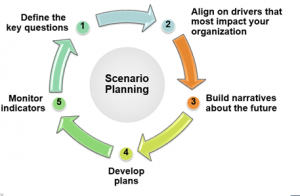Nonprofit leaders are facing an unprecedented mix of funding cuts, shifting policies, and rising needs in communities. In this moment, many organizations are leaning on scenario planning—a tool that helps prepare for multiple possible futures—so they can remain resilient and ready no matter what comes next. Scenario planning happens in five steps:

Adapted from Diana Scearce, Katherine Fulton, and the Global Business Network community’s “What If? The Art of Scenario Thinking for Nonprofits.”
Scenario planning isn’t just an internal exercise. It can also be a tool to bring others into your world during unprecedented times and help build alignment as well as help others see how they can support your work more deeply. How you communicate about it with staff, funders, and other partners is important to consider. Communicating effectively can strengthen trust, invite collaboration, and help people support your organization in meaningful ways.
Here are five steps to think about as you consider sharing your scenario planning process with key audiences.
Step 1: Consider Your Audience
Before you share anything, pause to consider:
- Who is the audience?
- Internal (staff, board): Staff and board members likely have some knowledge of the challenges the organization is going through but maybe don’t have the full details. They may be concerned about the financial health of the organization, a key program or service area, or their job security. Approaching this process with transparency and candor coupled with care and intention can strengthen staff morale and help teams work more deeply together around common challenges. Lean in where you can – this can start small.
- External (funders, partners, community): External stakeholders care about your success, and they may not be aware of challenges you’re going through. Sharing high-level updates could open opportunities for funding, support, or connections.
Step 2: Frame the Narrative
Help your audience understand both the challenges and the opportunities by addressing:
- The context: What’s happening around you (e.g., funding shifts, policy changes)? What are 1-2 factors that could have a big impact on your organization?
- The implications: How do these factors affect your organization’s work and future?
- The stakes: What’s at risk for your mission, community, or operations?
Step 3: Share Your Approach
Be clear about how you’re planning for the uncertain future:
- What plans or scenarios are you considering?
- Which parts of your work are steady, and which areas may face challenges?
- How are you preparing across your programs, operations, or finances?
Keep the focus on the big picture rather than every detailed action step.
Step 4: Explain How You’re Monitoring
Show that you’re not just planning once—you’re actively paying attention. Share the indicators you’re watching to determine how the situation is evolving, such as:
- Policy developments
- Funding commitments or shifts
- Community needs or demand for services
This helps stakeholders see you are adaptable and ready to respond as conditions change.
Step 5: Make a Call to Action
Every communication should end with clarity about what you want your audience to do. Possibilities include the following:
- For staff: Stay engaged, contribute ideas, help monitor key signals.
- For funders and partners: Provide flexible support, join advocacy efforts, or simply stay informed.
- For your community: Share your story, spread the word, or participate in programs.
Whether your ask is simple knowledge sharing, building trust, or mobilizing support, make it explicit.
Example from Black Female Project
After building their scenario plan, Black Female Project created a communication to share with donors and other external stakeholders. You can see their example here.
Tips for Effective Communication
- Be transparent, but not overwhelming. Consider what level of transparency is appropriate for your audience. For internal audiences, keep to a similar level of detail that you typically share with your staff and board—for example, now might not be the time to share detailed financials with the full staff if they’ve haven’t seen that level of detailed information before.
- Adapt by audience. Internal stakeholders will want a greater level of detail and transparency than external audiences might need. Consider what amount of information and what messages are most important for each audience you’re communicating with.
- Anchor in your mission. Connect the scenarios back to your mission and the people you serve. Frame your communication as an opportunity for solidarity and action in support of your mission.

